Do you use social media to promote your consulting services? Wondering how to attract and engage prospective customers?
In this article, you'll discover a strategic plan you can model to convert prospects into qualified leads and customers on social media.
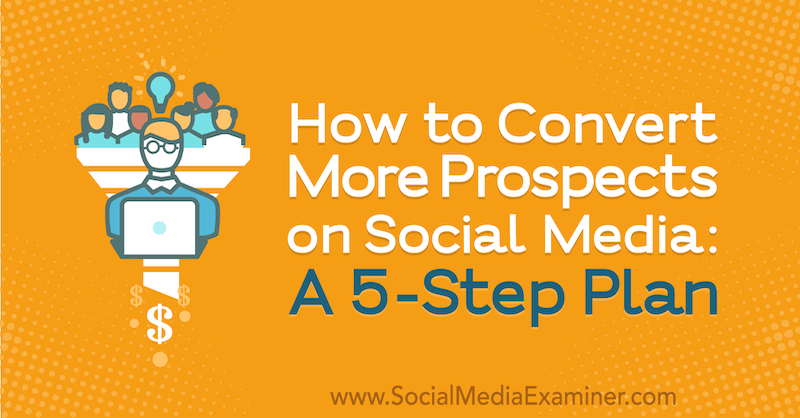
Why You Need an Engaging Sales Funnel on Social Media
In the world of digital marketing, consultants and funnels should go hand in hand. With no tangible products, consultants have to communicate the benefits of their services to justify the price. They can't simply show a product image or rely on the first emotional reaction.
The simple reason that consultants need a funnel in addition to a website or social media branding is to gain the trust of their clients. With trust-based niches like accountants or financial advisors, people don't jump on board in just a few minutes; they weigh their options. And while they're doing that, they're receiving messages from other consultants.
If you want to stand out in the competitive consulting niche, you have to act differently from the hundreds of consultants who connect with people on LinkedIn and send the sales pitch 5 minutes later. Your sales funnel should be designed to generate inbound leads instead of chasing after uninterested prospects.
Educating your customers and building a two-way conversation can help you create something called an “engagement funnel.” You increase the commitment at every stage of the funnel. Start with a micro-commitment, followed by a bigger step, and build trust and reciprocity along the way. Ask people to engage with your posts, offer to answer one question on social media, and you'll help them overcome their fear.
Now let's look at a funnel framework you can model to take care of the main elements of your marketing—awareness, interest, demand, and action—so you can land your ideal clients on autopilot.
#1: Use Your Ideal Customers' Pain Points to Define Your Positioning
Because consulting is a competitive niche, it's important to research the market and clearly identify your unique selling proposition (USP). This is the foundation of your marketing campaign so you need this to create a strong message. Your USP will help guide the social media messaging that will resonate with your ideal clients.
Of course, you first need to decide who you want to work with and attract to your business. Despite a common misconception, you can't work with just anyone. For starters, people need to have the money to hire you. Plus, they have to be motivated enough to take action within a reasonable timeframe.
Your USP will also help you stand out from competitors who are offering similar or complementary services. The main question you have to answer in your social media campaigns and throughout your sales funnels is, “How can I provide more value than my competitors?”
You can use Facebook ads or even polls on Instagram or LinkedIn as part of your initial market research to identify your potential clients' pain points. Here's an example of an effective market research post on LinkedIn:
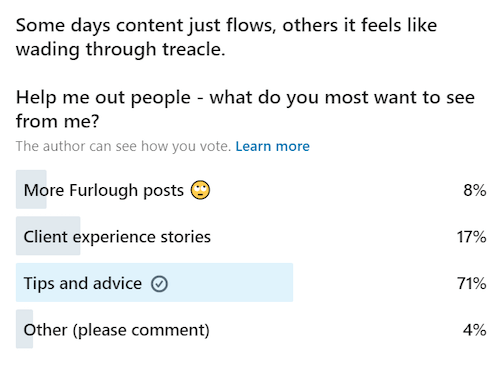
#2: Build Awareness With Cold Prospects via Content That Demonstrates Your Expertise
If you look at a sales funnel as a four-stage customer journey consisting of awareness, interest, demand, and action, it's clear you have to start with the first two stages to get the sale. For this, you need to create the right type of awareness.
Get World-Class Marketing Training — All Year Long!
Are you facing doubt, uncertainty, or overwhelm? The Social Media Marketing Society can help.
Each month, you’ll receive training from trusted marketing experts, covering everything from AI to organic social marketing. When you join, you’ll also get immediate access to:
- A library of 100+ marketing trainings
- A community of like-minded marketers
- Monthly online community meetups
- Relevant news and trends updates
One of the most valuable assets in your business is your reputation so it's important to showcase your results and talent. Here are a few ways to stand out in the crowded consulting market with unique and relevant branding content:
- Create and publish a blog post or LinkedIn article. This will help you show your expertise and connect with people on a cognitive and emotional level.
- Publish a book or eBook. This could be the beginning of your funnel and answer your potential clients' pain points.
- Do industry interviews. If someone who's considered a voice of reason and an expert will interview you, you can reach the right audience for free.
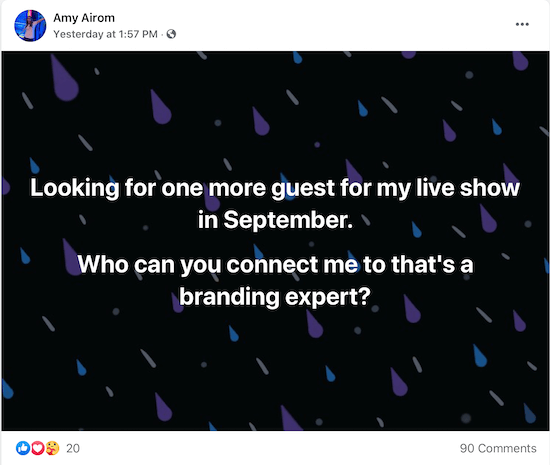
- Write guest posts. As with everything digital marketing, quality is more important than quantity. If you team up with another business that provides services to your target audience, you can start building an engaged audience.
- Create learning units for your Facebook group and broadcast live video. If you're new to social selling, you need to be present and provide value every day to gain the trust of your audience. Adding learning units to your Facebook group is one way to engage with your followers and create reciprocity.
#3: Run a Video Engagement Campaign to Warm Up Prospects
Once you know that people are listening and looking into your content, consider running a video views campaign on Facebook. The main reason this is effective is that it will help you build an audience to retarget. In a way, it's the first stage of a mini social media funnel.
All you need to do is create a video about the topics you identified as your customers' pain points. Once you've published the video, you can target a video engagement custom audience and pay a couple of cents for each video view at a time if you set the campaign up properly.
Of course, marketing—including social media—should not be a popularity contest. There's a huge difference between watching a video and engaging with the person, let alone paying for their services. Therefore, you'll need to add more touchpoints to the social media sales funnel before you ask for someone's business. That's the next step of the framework.
#4: Retarget Warm Prospects to Deliver a Valuable Resource
This is the stage of the social media sales funnel where most consultants give up and become impatient. You can't ask for the sale yet. Just as you wouldn't ask someone to marry you after a few dates, you need to give your prospects time to know, like, and trust you.

Discover Proven Marketing Strategies and Tips
Want to go even deeper with your marketing? Check out the Social Media Marketing Podcast! Publishing weekly since 2012, the Social Media Marketing Podcast helps you navigate the constantly changing marketing jungle, with expert interviews from marketing pros.
But don’t let the name fool you. This show is about a lot more than just social media marketing. With over 600 episodes and millions of downloads each year, this show has been a trusted source for marketers for well over a decade.
At this stage, you want to offer value that they can't resist.
From your video engagement campaign, you already know they're interested in the topic you covered about so why not give them something for free? Offer more value to create reciprocity.
This is where retargeting campaigns come in handy. Whether you're using Facebook, Twitter, LinkedIn, or another platform, the rules are the same: Introduce an offer that delivers huge value but only requires a micro-commitment from the client.
Here are some ways to do that:
- Create an eBook. This tactic is less popular than it used to be but if the eBook is laser-targeted to your audience and their problems, it can work wonders.
- Develop a video series exclusive to people who join you. Expand on the topic that interests your audience and you'll deepen the emotional relationship while creating reciprocity.
- Offer a free chapter of an eBook. This is my favorite method. Offer your prospects a free chapter, synopsis, or exercise from a book so they can “try before they buy.” Once they get their hands on the information, they can buy the book, which could lead to a resources page that has a funnel attached.
- Share worksheets and checklists. This content often works better than eBooks because it requires less of a time commitment. People are also more likely to open a document if it will make their life easier and provide practical tips and solutions.
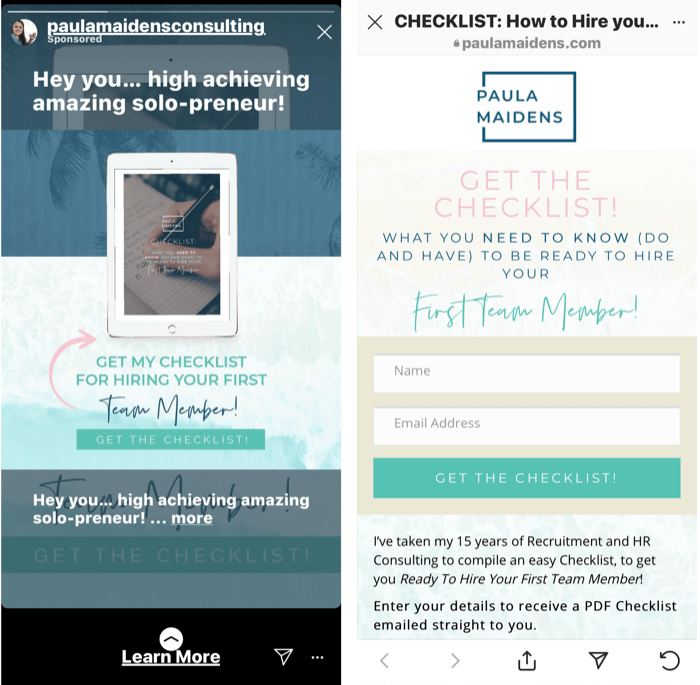
Of course, you can deepen the relationship if you ask for feedback on the content. In the age of social media, communication should be two-way and take place on multiple channels—email, Messenger bots, and posts.
Pro Tip: If someone downloaded your worksheet, ask them to share their experience. Create a workshop where you and the community can discuss the topic. This will not only create reciprocity and trust but also social proof.
#5: Qualify Your Leads Before Proposing a Meeting or Call
Another common mistake I see when consultants build their own funnels is that they get excited about the interest they've created and automatically assume there has to be some demand. That's not necessarily the case.
In fact, window shopping is more common on social media than on the high street. You'll find that there will be people who are engaging in wishful thinking or are “freebie seekers.” If you want to save yourself from a headache, you need to find a way to qualify your leads. After all, if you don't respect your time, other people won't either.
Offering a free consultation to anyone is like saying, “I'm not that busy; in fact, I am desperate and will work with the first person who walks through the door.” This isn't the image you want to project.
There are a few ways you can qualify your leads from your digital marketing campaigns, and these steps should always be implemented in your social media sales funnel:
- Build an application process into the booking system.
- Ask prospects about a financial commitment. “Are you in the position to invest in your XY development?”
- Check out the profile of the person requesting a consultation. This is a simple but effective tactic.
- Ask for a commitment. Make sure the prospect is aware that you won't do all of the work for them. Otherwise, you'll end up with a nightmare customer… You know, the one who emails you every day and calls you at 1 am.
You can also find out more about your prospects using a website quiz that will qualify your leads. The example below is from a funnel for a property investment training firm.

The above survey was designed to provide two different results based on the prospect's answers. If their responses suggested they were more serious, they were presented with a higher-value offer, while others were asked to read more on the topic and download a special report.
There is also a chatbot version of the same funnel that focuses on people who are engaging with the page.
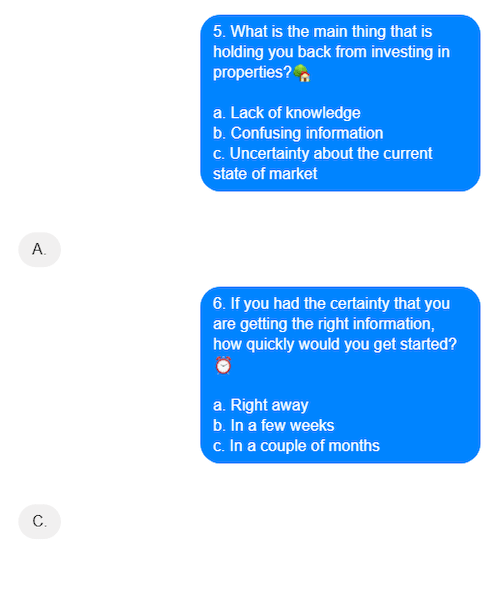
Once you've qualified your prospects, you can take the next step and propose a call or a meeting with them.
Conclusion
Of course, implementing the tips above will take time. When I build funnels, I work with funnel maps most of the time. Here's a plan that includes all of the elements of social media engagement funnels we talked about so you can implement them in your consulting marketing strategy:
- In the first stage, use engagement posts, social proof posts (testimonials, recommendations, etc.), guest blogs, LinkedIn articles, and videos to build an audience for retargeting. Also ask questions to find out more about the audience.
- In the second stage, retarget the traffic (audience from video views) with more value such as an eBook, checklist, worksheet, or exclusive video to build a deeper relationship.
- In the third stage, engage with people on a personal level. Ask questions, email them, and if you have a big-enough audience (2,000+), launch a webinar for those who would like to deepen their understanding even further.
- In the fourth stage, focus on inbound leads and qualification. Get them to take the first step and answer a few qualifying questions before they can book a consultation.
There's a lot of work to do before you can land a client after driving them down your social media funnel. Let's assume they're highly engaged with your content, ask the right questions, join your Facebook community, and even fill out a quiz on your website. They're fully tuned into your content but there's still a big gap between being a follower and becoming a customer. You have to build a bridge that's safe and strong, attractive, and leads them to the other side.
What do you think? How will you adapt this framework to convert prospects into qualified leads and customers for your consulting service? Share your thoughts in the comments below.
More articles on social media marketing:
- Discover a four-step process to audit and adjust your next marketing plan.
- Find tips for using organic content on LinkedIn, Facebook, and Twitter.
- Learn three techniques to produce video people will watch on social media.
Attention Agency Owners, Brand Marketers, and Consultants

Introducing the Marketing Agency Show–our newest podcast designed to explore the struggles of agency marketers.
Join show host and agency owner, Brooke Sellas, as she interviews agency marketers and digs deep into their biggest challenges. Explore topics like navigating rough economic times, leveraging AI, service diversification, client acquisition, and much more.
Just pull up your favorite podcast app, search for Marketing Agency Show and start listening. Or click the button below for more information.

